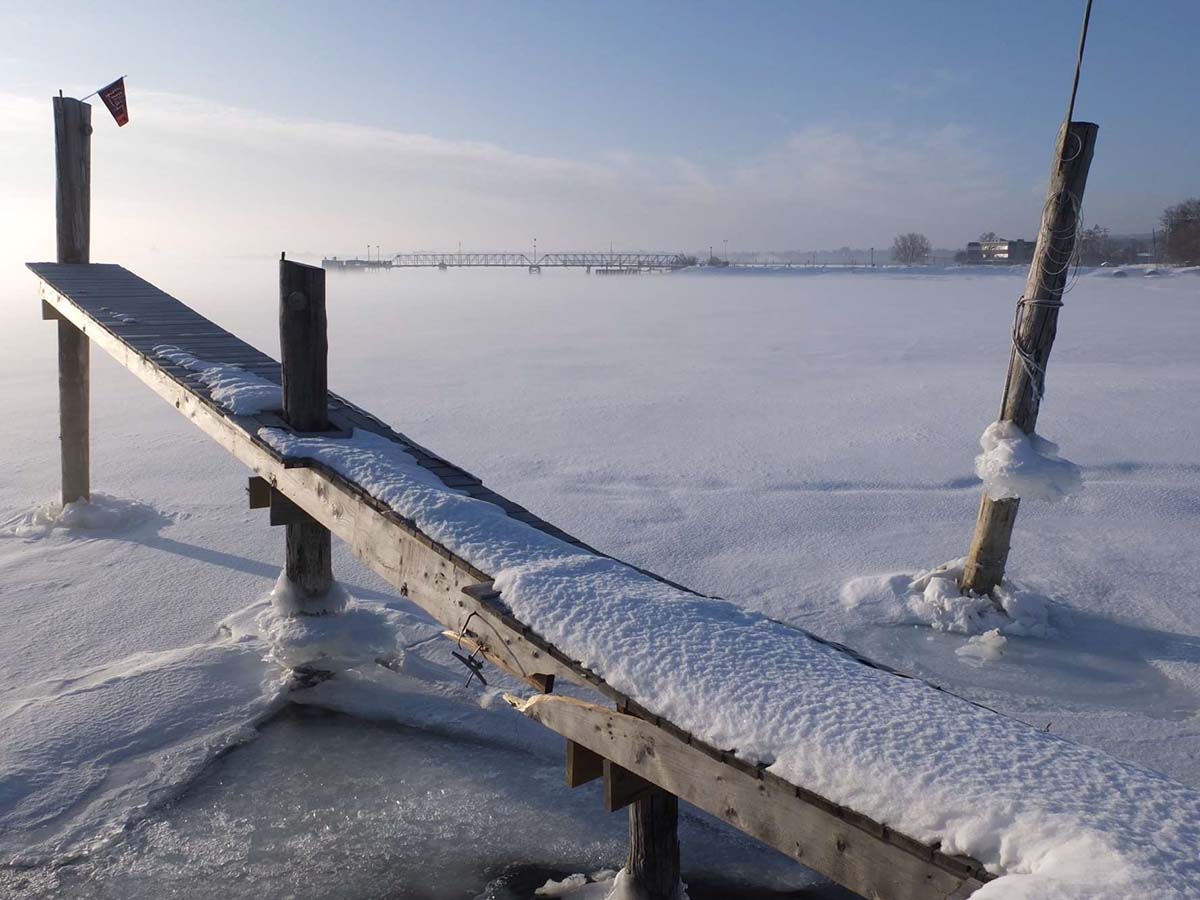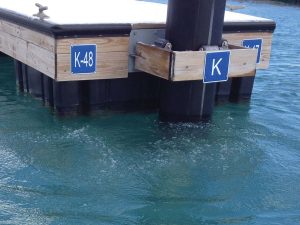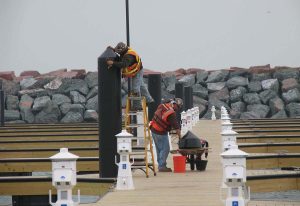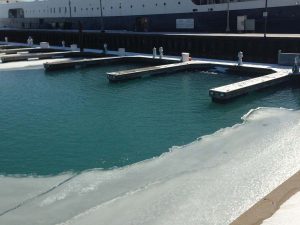
Winterization and Ice Mitigation Strategies
Published on August 15, 2023When most of us imagine marinas, the picture that comes to mind is a beautiful summer day, with a soft breeze blowing across sparkling blue water, and families heading out for a day of fun on the water. While this is the time of year our marinas see the most use, we often see far more damage to our facilities after our boaters have started thinking about football, the winter holidays, and colder weather.
When building a new marina, renovating an older facility, or rebuilding after a storm, it is critical to think through how your facility will weather the colder months, which may include snow, ice, power outages, higher winds, and bigger waves. Preparing your marina for winter weather starts with proper design, engineering, construction, and maintenance, and relies heavily on preparation and a solid operations team to respond to changing weather patterns and storms.
While most of us think climate change is mostly about warming temperatures and rising water levels, a key factor is the increase in storm intensity and much less stability in weather patterns. As a native of the Great Lakes, I’m used to heavy ice conditions, regular snowstorms that drop a foot or more of snow, high winds, and freezing temperatures. But in recent years, our friends as far south as Texas have seen snow and freezing temperatures. While maybe they didn’t get as much snow as we might be used to up north, their older covered dock systems may not have been engineered to deal with the storms we’re seeing now. This leads us to the first step, which is engineering new and replacement dock infrastructure to handle more intense, frequent, and unpredictable storms.

Proper engineering for dock systems and marine infrastructure begins with what we call the “Basis of Design” report. This document quantifies the site and environmental conditions of the infrastructure we need to design for. This obviously includes weather conditions such as wind and waves to design proper wave attenuation, but also geotechnical conditions so we can design appropriate anchorage systems to resist the forces of ice. When designing for ice specifically, the categories of potential ice damage we need to prepare for include compression/expansion, ice jacking, and ice shove.
Compression and expansion of ice can cause serious damage to piles when ice becomes trapped within an enclosed basin with no room for expansion. When this occurs, piles can be pushed over, bent, or otherwise displaced, which can also tear apart docks, framing, and pile guides. We minimize this type of damage by utilizing more flexible anchoring systems such as chain & anchor or flexible systems that can allow the docks to move with the ice without displacing the anchors, or by introducing ice mitigation measures that maintain areas of open water to allow ice to expand without damage. Interestingly, we rarely see compression damage to the dock structures themselves, and some dock systems ride up on top of the ice as it forms.
Ice jacking occurs when piles or equipment become locked in a sheet of ice. While it isn’t apparent from afar, the water under the ice is constantly moving up and down ever so slightly from currents or rain flows into the water body after storms. These small up and down movements exert a vertical force on the pile and over time can pull the pile completely out of the seabed. We minimize this issue through a number of measures. Most commonly, we utilize ice mitigation measures such as water circulators or submerged bubbler systems to reduce the buildup of ice near critical points such as piles, gangways, and utilities. With no ice, or at least a much thinner layer of ice near the things we’re trying to protect, the ice breaks up and exerts less force on

the piles. Another approach is through careful pile selection. Telescoping spud piles utilize a two-pile system, where an outer sleeve is fixed to the dock, and a thinner spud pile is inserted inside the outer pile. This allows the ice to freeze solid on the outer pile, while the whole system is free to ride up and down on the inner pile. Other approaches include using materials like steel piles that have smoother surfaces than wood piles for example, which again reduces the ability of the ice to hold onto the pile. Finally, using helical anchors or spin fin piles that create much more withdrawal resistance may be a good solution depending on the soil conditions. We have seen limited success with the installation of pile sleeves over the piles, which are intended to reduce ice friction.
Ice shove is the most challenging condition to prepare for. Ice shove is the force of a large mass of floating ice being driven into our docks, piles, and breakwaters by wind or currents. It can literally be the “irresistible force” and we have a very hard time building “immovable objects” (at least ones that we can afford!). The response here is to deflect and redirect rather than try and stop the ice altogether. While ice is very strong in compression, it is very weak in tension and will break into smaller pieces if we meet it with angled structures that direct the ice upwards. Imagine a “cow catcher” from the old steam locomotives in Saturday morning westerns… when the ice sheet hits a fixed structure that lifts and splits the ice, we can greatly reduce the loads we need to resist. This can be done with clusters of piles set at proper angles, stone “collars” around piles, or gently sloped rubble mound breakwaters. Keep in mind though that the ice will spill over the top of these structures and could build up on floating docks beyond. Ice and snow are very heavy, so we need to be sure our floating infrastructure is designed for proper snow loads, especially covered docks.
Ice Mitigation Systems
Selecting a proper ice attenuation/reduction strategy depends on location and budget. There are two main strategies. The first is submerged bubbler systems, which are generally made up of air lines submerged and anchored below the docks and piles, with dock-mounted compressors forcing air into the system. Millions of tiny bubbles generate an upward current that draws warmer water up to the surface to reduce ice buildup. The advantages of this system include a lower cost of operation, as less energy is used to drive the compressors. The disadvantage is in maintenance during the winter. If the system fails and a thick layer of ice builds up, getting to the lines below the ice can be very challenging.

The other approach to utilize “flow inducers”, such as those manufactured by Kasko or Ice Eater. These devices are simple electric-driven propellers that are suspended below the ice and generate significant water flow. These systems can be very effective at keeping larger areas of water open. They have several key advantages that include relatively low upfront costs (generally around $700-$1,000 per unit) and ease of maintenance. If one fails, all you need to do is cut a hole in the ice, drop in a circulator, and within a few hours you have open water. The potential downside is the cost of power needed to run them, which can be significant. For this reason, temperature sensors are available to turn them off when not needed.
Operations and Procedures
With a properly designed and constructed marina, the focus shifts to maintenance and operations. The time to check your piles, dock connections, walls, and wave attenuation systems for possible damage is during the summer, so you can line up repairs well before the snow flies. Check your compressors and lines for bubbler systems or check your circulator units and maybe have a spare on hand. Install lifting ladders to keep them out of the ice and torn off the docks.
During periods of freezing weather, we recommend operators check the ice mitigation systems daily to monitor proper operation. We recommend this process be completed with two-person teams, as the docks can be very slippery, and a second person should always be on hand in the event someone falls into the water. Another important note is to ensure that signs are posted to let the public know ice attenuation measures are in place, and the stability of the ice may not be safe.
Can Ice Actually Help Us?
When all else fails, maybe think about how to turn the tables and take advantage of the weather! A marina in Montreal did just this by building a marina with a flexible anchoring system that was designed to ice in completely. When winter comes, they install ice fishing tents or small structures in the slips. They keep the power on, and “boaters” can enjoy ice fishing while watching hockey all winter long! It’s a great way to increase revenues year-round.
| Categories | |
| Tags |






